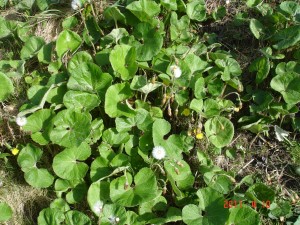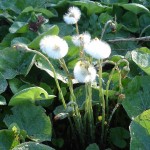Coltsfoot
Latin: Tussilago farfara
Irish: Sponc
Coltsfoot flowers can appear as early as February and are one of the earliest spring flowers that one sees at Castlewarden but they are often mistaken for small dandelions. It is a native perennial that grows abundantly on roadsides, on gravely banks and in damp fields. The flowers, on scaly, purplish stems, are yellow, solitary and relatively small (25-40mm across) and appear bef ore the leaves.
ore the leaves.
As the seed matures they are surrounded by a white, feathery pappus just like a small “dandelion clock” When the leaves appear they grow close to ground level as a rosette. They are 8-15cm across and are more-or-less round in outline and have a white, cottony appearance especially on the underside. The hoofprint outline of the leaf explains the common name – “coltsfoot”.
One of the traditional uses of the dried, downy leaves of Colsfoot was as tinder for lighting fires – the Irish name “Sponc” signifies “spark”. They have also been used as a substitute for tobacco and as an ingredient in cough lozenges and, when boiled in milk, they were used as a cure for asthma. The highly liver-toxic pyrrolizidine alkaloids contained in Coltsfoot are, apparently, destroyed by boiling.
Coltsfoot grows in abundance along the avenue (end nearest the clubhouse) and in the Builder’s Paddock.
